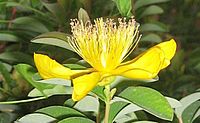Tutsan facts for kids
Quick facts for kids Tutsan |
|
|---|---|
 |
|
| Hypericum androsaemum | |
| Scientific classification | |
| Kingdom: | |
| Division: | |
| Class: | |
| Order: | |
| Family: |
Clusiaceae
|
| Genus: |
Hypericum
|
Tutsan (which means "all-healthy" in French) is a type of plant that grows like a small, bushy tree. It's found in many parts of Europe and Asia. This plant is known for its pretty golden yellow flowers that bloom in spring and its berries that change color from red to black when they are fully ripe. Its scientific name is Hypericum androsaemum. Tutsan has been used for a long time because people believed it had special healing properties. Another plant that looks quite similar to Tutsan is called St. John's wort (Hypericum perforatum).
Contents
What is Tutsan?
Tutsan is a shrub, which means it's a woody plant smaller than a tree. It can grow up to about 1 meter (3 feet) tall. It has many branches, making it look bushy. The leaves are oval-shaped and grow in pairs along the stems. They are usually a fresh green color.
Flowers and Berries
The flowers of the Tutsan plant are bright golden yellow. They have five petals and many stamens, which are the parts that produce pollen. These flowers usually appear in the late spring and early summer.
After the flowers fade, small berries start to grow. At first, these berries are a bright red color. As they get older and ripen, they turn a shiny black. These berries are a favorite food for many birds.
Where Tutsan Grows
Tutsan is native to a wide area. You can find it growing naturally in parts of Western Europe, including countries like the United Kingdom, France, and Spain. It also grows in parts of Asia, such as Turkey and the Caucasus region.
Preferred Habitats
This plant likes to grow in places where there is some shade, but also enough sunlight. It's often found in woodlands, along the edges of forests, and in hedgerows. It can also grow in rocky areas or on slopes. Tutsan prefers soil that is moist but drains well.
Life Cycle of Tutsan
The Tutsan plant follows a yearly life cycle. In the spring, new leaves and shoots begin to grow. This is when the plant starts to look green and vibrant again after the colder months.
Blooming and Fruiting
The golden yellow flowers bloom during late spring and early summer. Bees and other insects visit these flowers to collect nectar and help the plant make seeds. After the flowers are pollinated, the berries begin to form. They start green, then turn red, and finally black when they are fully ripe in late summer or early autumn.
Winter Rest
As autumn arrives, the leaves of the Tutsan plant may change color before falling off. The plant then goes into a resting period during the winter. It waits for the warmer temperatures of spring to start its growth cycle all over again.
Tutsan and Similar Plants
Tutsan belongs to a group of plants called Hypericum. This group includes many different species, and some of them look quite similar to Tutsan.
St. John's Wort
One of the most well-known plants in the Hypericum family is St. John's wort (Hypericum perforatum). This plant also has yellow flowers, but its leaves have tiny clear dots that look like holes when you hold them up to the light. These dots are actually glands that contain special oils. St. John's wort is famous for its use in traditional medicine.
While Tutsan and St. John's wort are related and look alike, they are different species. It's important to know the difference, especially if you are learning about plants.
See also
 In Spanish: Hypericum androsaemum para niños
In Spanish: Hypericum androsaemum para niños

